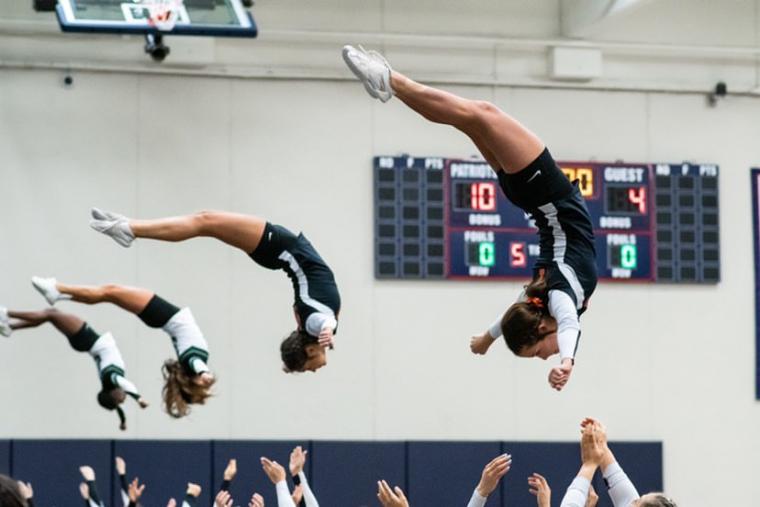
 IIn a season full of cancelled competitions and closed-down campuses, USA Cheer has some welcome good news to share. STUNT, the organization’s all-female sport, has been added to the NCAA’s roster of Emerging Sports for Women. It now begins the climb to championship sport status.
IIn a season full of cancelled competitions and closed-down campuses, USA Cheer has some welcome good news to share. STUNT, the organization’s all-female sport, has been added to the NCAA’s roster of Emerging Sports for Women. It now begins the climb to championship sport status.
STUNT, which is one of the fastest-growing female sports in the country, removes the crowd-leading element and focuses on the technical and athletic components of cheer, including partner stunts, pyramids, basket tosses, group jumps and tumbling. These elements are put together in short routines that two teams (each representing a different school) must perform head-to-head on the floor at the same time. The team that executes the skills best wins the round and the point and also has the opportunity to determine which of routine level will be called next. With four quarters of play (divided into partner stunts, pyramids & tosses, jumps & tumbling, and team routine) STUNT is an exciting sport to play, coach and watch.
USA Cheer created STUNT as an opportunity for colleges, universities and high schools to meet Title IX requirements. With more than 500,000 high school cheerleaders moving on to college, STUNT expands participation opportunities for young women by providing an avenue for female athletes to use their cheerleading background in a new format.
Under the rules of the NCAA, in order for a sport to reach championship status, a minimum of 40 schools need to be offering it as a varsity sport, or 28 at the DIII level.
SDM caught up to USA Cheer’s Executive Director, Lauri Harris, to get her comments on the sport and its chances (hint: they’re good and it’s already making serious inroads).

Lauri Harris: We had 39 programs this Spring season that played with a shortened schedule due to COVID-19, and another 12 that are committed for the 2021 season.
Editor’s note: A list of colleges with STUNT programs can be found here.
SDM: STUNT is really on its way! What is the difference between having programs and being a varsity sport at the collegiate level?
Harris: To be a varsity sport, the athletic department has to sponsor them under athletics, it has to be treated like any other sport that is representing the school, such as basketball, soccer or volleyball.
SDM: How are most of the STUNT programs classified now?
Harris: We have a mix. Some of our programs are club and some are varsity. Club sports are really a great way to get things going across the country – the students get interested and work on starting a club, and the schools can adopt it as a varsity sport later.
SDM: With so many schools already sponsoring club & varsity programs, do you have any idea of how long it might take until STUNT is able to apply for championship sport status with NCAA?
Harris: With our current interest and focus on expansion, it really feels like we’ll be able to get there in three to five years.
SDM: Is cheer currently a championship sport in college?
Harris: No, not under the NCAA. Colleges do take part in competitive programs, though.
SDM: The NCAA’s Emerging Sports for Women right now includes equestrian, rugby, triathlon, acrobatics & tumbling, and STUNT. What do you need to educate people on, so that they understand STUNT is different from acrobatics & tumbling?
Harris: Acrobatics & tumbling is more gymnastics-based, whereas STUNT is more cheer-based.
SDM: What do you think it is that attracts student athletes to STUNT, as opposed to competitive cheer at the collegiate level?
Harris: I would say the opportunity for more people to be involved, based on what they do best. In a competitive cheer program, you might need 12, 16 or 20 people, and they all need to be able to do everything well – tumbling, partner stunts, pyramids and so on. In STUNT, it’s different. There are different quarters to a match, and each represents a different skill set. You’re able to put your strongest people on the floor in any given quarter. So, for example, if you’re great at partner stunts but not at tumbling, there’s still a place for you. You’re part of a team that values your strengths. It’s not that different from other sports and their specialized positions, like football for example where you have people with different positions, based on their skills. They might be a wide receiver, a quarterback or a kicker. That’s what we’ve heard coaches love the most. They can keep a roster of athletes who have specific skills rather than just cutting people in favor of finding someone who can do everything.
SDM: It also sounds like it’s interesting for spectators because their school’s team is on the floor all the time; they don’t have to wait for them to perform their routine.
Harris: Exactly. There’s no waiting and you can find out who’s ahead right away.
SDM: Moving on to the competitive aspect of college STUNT. How do you select the location for championships?
Harris: We tend to host our championship where there is a concentration of STUNT programs at both the high school and college level. Right now, that means Texas, Oklahoma, California and Michigan.
SDM: Is it expensive for colleges to start a STUNT program?
Harris: No, it’s a super-low cost to get started. Your facilities, meaning your gym, are already existing. All you need are some mats – you may have those already but even if you don’t, they’re not all that expensive and they’ll last 10 to 15 years before they need to be replaced. The uniforms are inexpensive; they’re very similar to volleyball uniforms.
SDM: Obviously, there’s no great time for a pandemic to hit but it has to be frustrating that STUNT can’t take advantage of the momentum as easily right now.
Harris: It’s not the best timing, but amidst all this, we’ve still gotten so many inquiries; a lot of campuses are saying, “Well, this is not something we can do this year but maybe next year.”
SDM: It’s great to be able to give students who cheered in high school something to do in college, and possibly even at the varsity level.
Harris: Yes, this is just one additional avenue to be able to do the things they enjoy and are skilled at the collegiate level.
SDM: And another athletic program is always good for marketing the school and attracting students.
Harris: STUNT allows colleges to get more students on their campus. If universities are worried about Title IX, it gives them another sport for that. It kind of hits every bucket.
SDM: Are you seeing STUNT at the lower levels as well?
Harris: Yes, we are. It’s growing at the high school level and at the youth level. We had over 6,000 high school athletes this spring and nearly 1,000 youth athletes in its first season! The growth is exciting.
SDM: Are we seeing or will we be seeing STUNT at the all-star level?
Harris: We’re encouraging all-star programs to consider adding STUNT in their gym, CLUB STUNT. We’ve had gyms dabbling in it with a lot of success; it’s helping them figure out how it will work for their gyms and their current schedules. It can bring new girls into the gym, which is always great!

